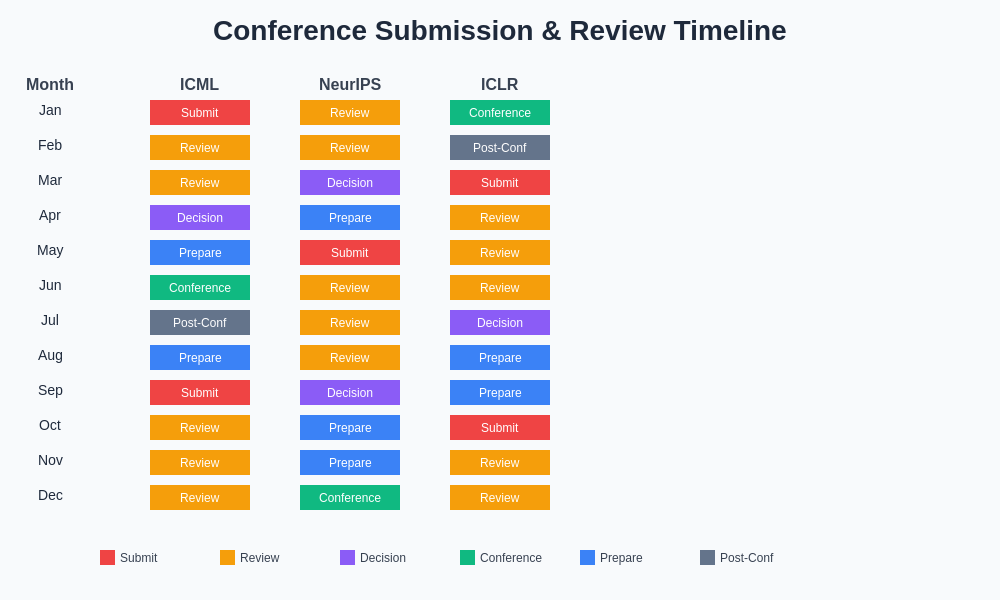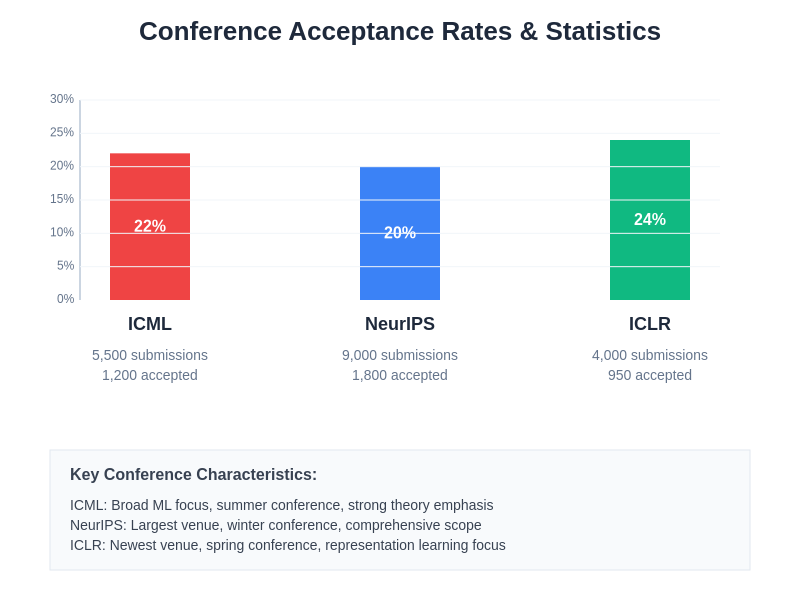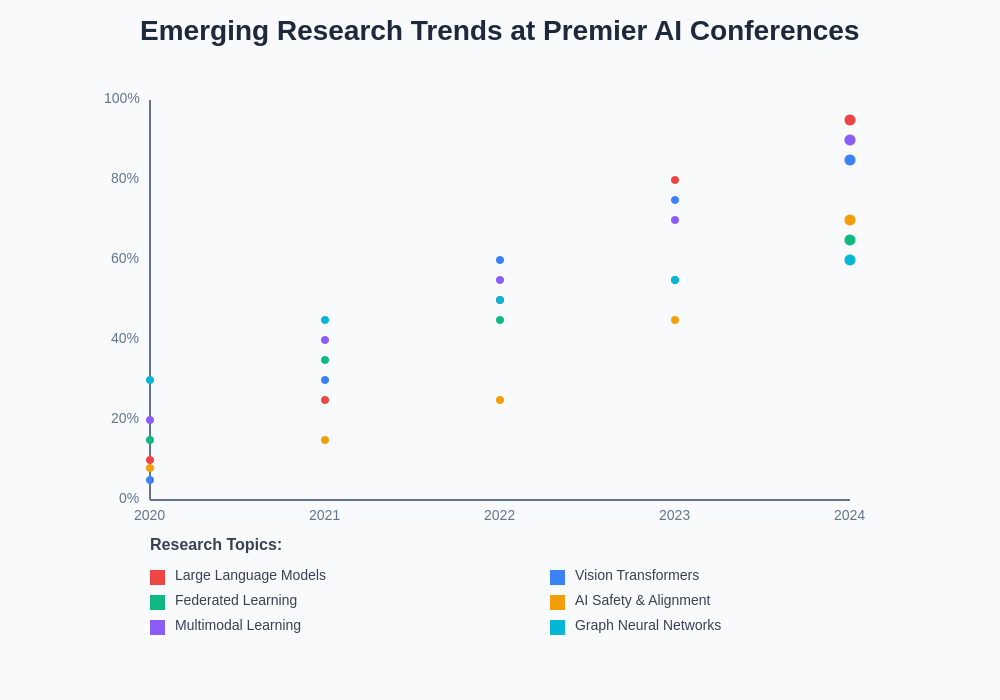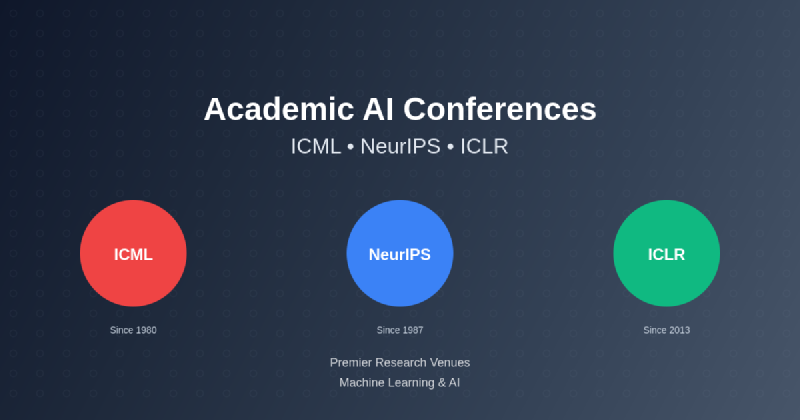The academic artificial intelligence landscape is dominated by three premier conferences that serve as the cornerstone of machine learning and AI research dissemination worldwide. The International Conference on Machine Learning (ICML), Conference on Neural Information Processing Systems (NeurIPS), and International Conference on Learning Representations (ICLR) represent the most prestigious venues for researchers, practitioners, and industry leaders to present groundbreaking work, engage in intellectual discourse, and shape the future direction of artificial intelligence research. These conferences have become essential gathering points where the most innovative ideas in machine learning are unveiled, debated, and refined, making them indispensable for anyone serious about understanding and contributing to the advancement of artificial intelligence.
Explore the latest AI research trends and breakthroughs to stay informed about cutting-edge developments being presented at these premier academic venues. The influence of these conferences extends far beyond their immediate attendees, as the papers presented often become the foundation for future research directions, industry applications, and technological innovations that transform how we interact with and benefit from artificial intelligence systems.
The Landscape of Premier AI Conferences
The hierarchy of academic artificial intelligence conferences has evolved significantly over the past several decades, with ICML, NeurIPS, and ICLR establishing themselves as the triumvirate of machine learning research excellence. These conferences have transcended their original scope to become comprehensive platforms that encompass theoretical foundations, practical applications, and interdisciplinary collaborations that bridge computer science, mathematics, neuroscience, and numerous other fields. The competitive nature of these venues, combined with their rigorous peer review processes, ensures that only the most innovative and impactful research reaches publication, maintaining their reputation as the gold standard for artificial intelligence scholarship.
The significance of these conferences extends beyond mere academic recognition, as they serve as crucial networking hubs where collaborations are formed, career trajectories are shaped, and industry partnerships are established. Major technology companies, research institutions, and funding agencies closely monitor the proceedings of these conferences to identify emerging trends, recruit top talent, and guide strategic research investments. The presentations, workshops, and informal discussions that occur during these events often catalyze breakthrough discoveries and technological advances that subsequently reshape entire industries.
International Conference on Machine Learning (ICML)
The International Conference on Machine Learning stands as one of the oldest and most respected venues in the machine learning community, tracing its origins back to 1980 when it began as a small workshop focused on computational learning theory. Over the decades, ICML has evolved into a comprehensive conference that attracts thousands of researchers from around the world, presenting work that spans the entire spectrum of machine learning research from fundamental theoretical advances to practical applications that solve real-world problems.
ICML’s review process is renowned for its thoroughness and intellectual rigor, typically involving multiple rounds of peer review by experts in relevant subfields. The conference maintains high standards through a careful selection of program committee members and area chairs who possess deep expertise in their respective domains. This meticulous approach to quality control ensures that accepted papers meet stringent criteria for novelty, technical soundness, and potential impact on the field. The acceptance rate for ICML typically ranges between 20-25%, reflecting the highly competitive nature of the venue and the exceptional quality of work required for publication.
The conference covers an extraordinarily broad range of topics including supervised and unsupervised learning, reinforcement learning, optimization theory, statistical learning theory, deep learning architectures, natural language processing, computer vision, robotics applications, and emerging areas such as federated learning and AI safety. This comprehensive scope makes ICML particularly valuable for researchers who seek to understand how their work fits within the broader context of machine learning research and who wish to explore interdisciplinary connections that might inspire new research directions.
Enhance your research capabilities with advanced AI tools like Claude to accelerate your paper writing, data analysis, and literature review processes for conference submissions. The integration of AI assistance into the research workflow has become increasingly important for maintaining competitiveness in these highly demanding academic environments.
Conference on Neural Information Processing Systems (NeurIPS)
NeurIPS, formerly known as NIPS until its name change in 2018, represents the largest and most influential gathering in the artificial intelligence research community. Founded in 1987, the conference has grown from a modest meeting focused on neural networks to a massive interdisciplinary event that attracts over 10,000 attendees annually, making it not only the most prestigious but also the most socially significant conference in the field. The sheer scale of NeurIPS creates unique opportunities for networking, collaboration, and knowledge exchange that are unmatched in the academic world.
The conference’s scope has expanded dramatically beyond its neural network origins to encompass virtually every aspect of machine learning and artificial intelligence research. Contemporary NeurIPS proceedings include work on deep learning, probabilistic modeling, optimization algorithms, theoretical analysis of learning systems, applications in healthcare and scientific computing, ethical considerations in AI deployment, and emerging areas such as quantum machine learning and neuromorphic computing. This broad inclusivity reflects the conference’s evolution into a comprehensive forum for all aspects of intelligent systems research.
The review process for NeurIPS is particularly noteworthy for its scale and sophistication, involving thousands of reviewers organized into a hierarchical structure of area chairs, senior area chairs, and program chairs. The conference has pioneered several innovations in peer review, including author response periods, reviewer calibration procedures, and transparency initiatives that have been adopted by other major venues. Despite receiving over 9,000 submissions annually, NeurIPS maintains acceptance rates around 20-25%, ensuring that the conference continues to represent the highest quality research while accommodating the growing volume of work in the field.
International Conference on Learning Representations (ICLR)
ICLR represents the newest addition to the triumvirate of premier AI conferences, having been established in 2013 with a specific focus on the emerging field of representation learning and deep neural networks. Despite its relatively recent inception, ICLR has quickly established itself as an essential venue for cutting-edge research in deep learning, attracting submissions from the most prominent researchers in the field and consistently featuring work that pushes the boundaries of what is possible with artificial neural networks.
The conference was founded with a commitment to open and transparent review processes, pioneering the use of open peer review where reviews and author responses are publicly visible throughout the review process. This innovative approach to scholarly publishing has influenced practices across the broader machine learning community and reflects ICLR’s dedication to fostering constructive scientific discourse. The conference also embraces rapid publication cycles and encourages submission of work that challenges conventional wisdom or explores novel architectural paradigms.
ICLR’s focus on representation learning encompasses a wide range of topics including deep generative models, attention mechanisms, transformer architectures, self-supervised learning approaches, multi-modal learning systems, and theoretical analysis of neural network optimization dynamics. The conference has become particularly known for featuring breakthrough architectural innovations and training methodologies that subsequently become standard practices throughout the machine learning community. Major advances in areas such as large language models, diffusion models, and vision transformers have frequently debuted at ICLR before gaining widespread adoption.
Utilize comprehensive research tools like Perplexity to conduct thorough literature reviews and stay current with the rapidly evolving research landscape across all three premier conferences. The ability to efficiently process and synthesize vast amounts of research literature has become crucial for researchers attempting to make meaningful contributions to these highly competitive venues.
Submission Processes and Timeline Management
Successfully navigating the submission processes for ICML, NeurIPS, and ICLR requires careful planning and adherence to specific timelines that vary across conferences and change annually. Each conference operates on distinct schedules, with submission deadlines typically occurring several months before the actual conference dates to allow for thorough peer review and revision processes. ICML submissions are generally due in late January or early February for conferences held in summer, while NeurIPS follows a similar timeline with submissions due in late spring for December conferences. ICLR operates on a different cycle, with submissions typically due in late fall for conferences held in the following spring.
The preparation process for conference submissions extends far beyond simply writing and formatting papers according to conference guidelines. Successful submissions require months of preliminary research, experimentation, analysis, and iterative refinement of both technical content and presentation quality. Researchers must carefully consider the fit between their work and the conference’s scope, audience expectations, and review criteria. The most successful submissions demonstrate clear contributions to existing knowledge, provide rigorous experimental validation, and present findings in a manner that is accessible to the broader machine learning community.

Understanding the cyclical nature of conference submissions and review processes is crucial for strategic planning of research activities. Each conference operates on distinct schedules that require careful coordination to maximize submission opportunities while maintaining research quality and avoiding conflicts between overlapping deadlines.
Each conference has developed specific formatting requirements, submission guidelines, and supplementary material policies that must be followed precisely to avoid desk rejection. These requirements cover everything from page limits and citation formats to code availability and reproducibility standards. The increasing emphasis on reproducible research has led all three conferences to implement policies requiring authors to provide implementation details, datasets, and code when possible, reflecting the community’s commitment to scientific rigor and transparency.
Review Criteria and Quality Standards
The review processes employed by ICML, NeurIPS, and ICLR represent some of the most rigorous and comprehensive evaluation systems in academic publishing, involving multiple stages of assessment by experts with deep knowledge in relevant research areas. Reviewers evaluate submissions based on several key criteria including technical quality, novelty of contributions, experimental rigor, clarity of presentation, and potential impact on the field. The multi-round review process typically includes initial reviews, author response periods, reviewer discussions, and final recommendation phases that ensure thorough evaluation of every submission.
Technical quality assessment focuses on the soundness of methodology, appropriateness of experimental design, statistical significance of results, and proper comparison with existing approaches. Reviewers examine whether the proposed methods are theoretically justified, whether experiments are designed to test relevant hypotheses, and whether conclusions are supported by presented evidence. The standards for technical rigor have increased substantially over the years, with contemporary submissions expected to include comprehensive ablation studies, statistical significance testing, and comparison with multiple baseline approaches.
Novelty evaluation requires reviewers to assess whether proposed contributions represent meaningful advances over existing work, rather than incremental modifications of established techniques. This evaluation requires deep familiarity with current research literature and the ability to identify subtle but important distinctions between new work and previous contributions. The most highly regarded submissions typically introduce fundamentally new approaches, provide novel theoretical insights, or demonstrate significant performance improvements across challenging benchmark tasks.

The competitive landscape of these premier conferences is reflected in their selective acceptance rates, which typically range from 20-25% across all three venues. These statistics underscore the importance of submitting high-quality, well-prepared manuscripts that meet the rigorous standards expected by the research community.
Research Trends and Emerging Topics
The evolution of research topics presented at ICML, NeurIPS, and ICLR provides valuable insights into the trajectory of artificial intelligence research and the emergence of new paradigms that shape the field’s future direction. Over the past decade, these conferences have witnessed dramatic shifts in research focus, from traditional machine learning approaches to deep learning architectures, and more recently toward foundation models, multimodal learning, and AI safety considerations. Understanding these trends is crucial for researchers seeking to position their work within the contemporary research landscape and identify emerging opportunities for impactful contributions.
The rise of large language models and transformer architectures has dominated recent conference proceedings, with submissions exploring everything from novel attention mechanisms and scaling laws to applications in diverse domains such as protein folding prediction and mathematical theorem proving. This trend reflects the broader impact of transformer-based models across virtually every area of machine learning and artificial intelligence research. Concurrent with this focus on large-scale models, there has been growing interest in efficiency considerations, including model compression techniques, knowledge distillation approaches, and methods for reducing computational requirements while maintaining performance.
Emerging areas of research that are gaining prominence at these conferences include AI alignment and safety research, federated learning systems, quantum machine learning approaches, and the integration of symbolic reasoning with neural learning systems. These topics reflect both technological advances and growing awareness of the societal implications of artificial intelligence systems. The conferences have also seen increased attention to fairness, interpretability, and robustness considerations, indicating the field’s maturation and recognition of the importance of responsible AI development practices.

The trajectory of research interests at these conferences reveals clear patterns in the evolution of artificial intelligence research priorities. Topics such as large language models and vision transformers have experienced explosive growth, while areas like federated learning and AI safety have shown steady increases in prominence, reflecting both technical advances and changing societal priorities.
Networking and Professional Development Opportunities
The value of attending ICML, NeurIPS, and ICLR extends far beyond the formal presentation of research results, encompassing extensive networking opportunities, professional development activities, and exposure to cutting-edge ideas that can catalyze future research directions. These conferences provide unique environments where researchers at all career stages can interact with leading experts in their fields, form collaborative relationships, and gain insights into emerging research opportunities and industry trends.
The workshop and tutorial components of these conferences offer particularly valuable learning opportunities, providing in-depth exploration of specific topics that may not be covered comprehensively in regular conference sessions. These events often feature expert presentations on emerging methodologies, hands-on training sessions, and panel discussions addressing current challenges and future directions in specific research areas. For graduate students and early-career researchers, these workshops provide essential background knowledge and practical skills that complement formal academic training.
Industry presence at these conferences has grown substantially, with major technology companies sponsoring events, recruiting talent, and presenting research conducted in industrial settings. This industry engagement provides valuable perspectives on the practical applications of academic research and opportunities for researchers to understand how their work might translate into real-world impact. The informal networking opportunities during poster sessions, social events, and conference breaks often prove as valuable as formal presentations for building professional relationships and discovering collaboration opportunities.
Publication Impact and Career Implications
Publication at ICML, NeurIPS, or ICLR carries significant weight in academic career advancement, industry recognition, and research impact assessment. These venues are consistently ranked among the top-tier conferences in computer science and artificial intelligence, with papers published at these conferences typically receiving substantial citation counts and influencing subsequent research directions. The prestige associated with these publications can significantly enhance career prospects, funding opportunities, and professional recognition within the research community.
The citation impact of papers published at these conferences often extends far beyond the immediate machine learning community, influencing research in related fields such as computer vision, natural language processing, robotics, and computational neuroscience. This cross-disciplinary influence reflects the fundamental nature of the methodological contributions typically presented at these venues and their applicability across diverse problem domains. Researchers who consistently publish at these conferences often become recognized as thought leaders in their respective areas and frequently receive invitations to serve on editorial boards, program committees, and advisory panels.
For industry professionals, publications at these conferences demonstrate technical expertise and research capability that can be valuable for career advancement, technology transfer initiatives, and establishing credibility within the broader AI community. Many successful startup companies and research labs have been founded by individuals who gained recognition through contributions to these conferences, highlighting their role as platforms for both academic and entrepreneurial success.
Future Directions and Conference Evolution
The landscape of academic AI conferences continues to evolve in response to changing research priorities, technological advances, and community needs. ICML, NeurIPS, and ICLR have all implemented various innovations in recent years to address challenges associated with rapid growth, maintain review quality, and adapt to changing research paradigms. These adaptations include experimentation with different review formats, implementation of virtual and hybrid conference models, and development of new mechanisms for managing the increasing volume of submissions.
The COVID-19 pandemic accelerated the adoption of virtual conference technologies, leading to hybrid models that combine in-person and remote participation. This evolution has made these conferences more accessible to researchers who previously faced financial or logistical barriers to attendance, potentially democratizing participation and broadening the diversity of contributions. The long-term implications of these changes remain to be seen, but they represent significant shifts in how academic conferences operate and serve their communities.
Looking toward the future, these conferences will likely continue to grapple with questions of scale, quality control, and community engagement as the field of artificial intelligence continues its rapid expansion. The emergence of new research paradigms, such as foundation models and AI alignment research, may necessitate adaptations in review criteria, conference organization, and the balance between different types of contributions. The ongoing evolution of these premier conferences will undoubtedly continue to shape the trajectory of artificial intelligence research and the careers of the researchers who contribute to this dynamic field.
The integration of artificial intelligence tools into the research process itself presents both opportunities and challenges for these conferences. While AI assistance can enhance research productivity and paper quality, it also raises questions about authorship, originality, and the appropriate use of automated tools in academic work. The conference organizers and research community will need to navigate these considerations carefully to maintain the integrity and value of these premier venues while embracing beneficial technological advances.
Disclaimer
This article is for informational purposes only and provides general guidance about academic AI conferences. Specific submission requirements, deadlines, and procedures may vary and change over time. Readers should consult official conference websites and guidelines for the most current and accurate information. The views expressed regarding conference prestige and career implications reflect common perceptions within the academic community but may not apply universally to all career paths or institutional contexts. Success in academic publishing depends on many factors beyond conference venue selection, including research quality, presentation clarity, and alignment with reviewer expertise.
